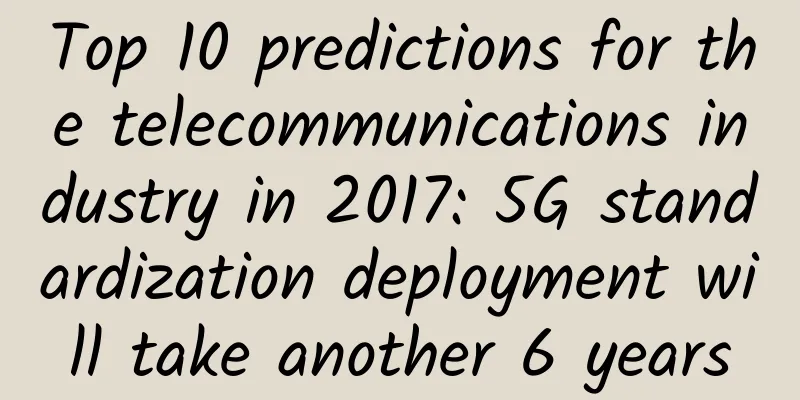Top 10 predictions for the telecommunications industry in 2017: 5G standardization deployment will take another 6 years

|
Telecoms.com has teamed up with mobile industry consultancy Northstream to present its top 10 predictions for the telecoms industry in 2017. 1. 5G standardization deployment will still take at least six years, but 4G deployment is accelerating We do not expect fully standardized, standalone commercial deployments of mobile 5G technology from operators until 2019-2020. While Verizon plans to begin trialing 5G in the form of fixed wireless access (FWA) in late 2017, we expect large-scale deployments of 5G will still take at least six years. Northstream predicts that operators will invest heavily in advancing LTE standards before then, rather than going all-in on 5G before it is fully standardized. Telecom companies will continue to invest in evolving LTE-Advanced, with key measures including cell densification, multiple-input multiple-output, and carrier aggregation (in both licensed and unlicensed spectrum). The cost of deploying 5G will be significant, and operators will only invest in 5G if the technology can provide significant advantages over 4G standards. Most operators will first ensure that the three main use cases associated with 5G are economically viable: (1) massive IoT, (2) ultra-reliable communications, and (3) enhanced mobile broadband (eMBB). 2. 5G will encounter the embarrassment of "Emperor's New Clothes" As mentioned above, much of the work on possible 5G speeds has already begun. Carrier aggregation has been around for a while, but we are getting better at it, and the trend towards building multiple parallel pipes (i.e., multiple-input, multiple-output) continues. We get news of a new wireless speed record being set almost every day, and it is expected that by this time next year, the 1Gbps 5G goal will likely be achieved on commercial networks. The endless stream of “near-5G” announcements that filled 2016 felt hollow. The telecoms industry has an unhealthy reliance on the next “G” to drive publicity and commercial activity, so the hype around 5G is understandable and inevitable, but it is not correct. Telecoms.com is concerned that marketers across the industry are at risk of overusing the term to the point where it becomes meaningless, and their target audiences lose enthusiasm. 3. Infrastructure suppliers’ market share stabilizes and pricing pressure eases Northstream believes that in the next few years, a lot of network investment will be in upgrading existing facilities rather than building new ones. In addition, we also believe that operators are eager to maintain the balance of power among the top three global suppliers. This will help stabilize market share and will ease pricing pressure on infrastructure suppliers. In the long term, increasing price pressure will further force infrastructure suppliers to consolidate - which will create an unbalanced and operator-unfavorable market. It is in the best interest of operators to maintain at least three global suppliers to ensure long-term competition and technology development. 4. Ericsson will prepare for acquisitions It’s no secret that Ericsson had a tough 2016. The headwinds that had plagued the company for years — primarily weakness in its core network market and its inability to diversify quickly enough to compensate — seemed to intensify, and CEO Hans Vestberg was forced to be sacrificed for the team, ultimately replaced by B?rje Ekholm, who had been the CEO of Ericsson’s largest shareholder. While there aren't necessarily many favorable alternatives -- and Ericsson may have learned its lesson from the Nokia disaster caused by Elop -- it's not clear why Ekholm stands out. Ericsson's share price has almost halved this year, and shareholders are likely to be unhappy. Ekholm's task is clearly to recover some of the losses. Telecoms.com believes that the best outcome for shareholders is likely to be to continue to reduce staff until the business starts to get back on track. 5. The hype of network function virtualization is over, and the time for real take-off has come Northstream predicts that network function virtualization activities will break out and grow strongly in 2017. Operators' incentives to implement such technologies are high because some new services (such as VoLTE) will benefit from virtualized network functions, and some future network functions (such as network slicing) will also rely heavily on this technology. Therefore, network function virtualization in 2017 will be driven by services such as VoLTE, operator cloud, Wi-Fi calling, service chaining, resource sharing and network slicing. At the same time, network function virtualization will be driven by the natural evolution of existing infrastructure rather than as a replacement strategy for operators. While the focus remains on improving operational efficiency, the real driver will be the new services created by network function virtualization. For example, network function virtualization technology provides services for network function service chaining; this means that network services can be dynamically configured in software without changing the network at the hardware level. More importantly, a new set of services that rely on network function virtualization are emerging. 6. Telecom companies and media will become increasingly difficult to distinguish Verizon’s failure to divest Yahoo suggests that operators are eager to diversify and quickly get into media activities. The fashionable solution to reduce operators’ average revenue per user is a diversified model - not just bundling content and connectivity, but owning these services. Expanding this strategy will make consumers turn to a small number of suppliers to meet their various technology needs - hardware, connectivity, content, IoT, in-car infotainment, etc. Europe is also seeing telecom and media consolidation, and Telecoms.com believes we will see M&A move in the other direction: content and internet service providers moving into connectivity. On the vendor side, an alternative pivot for Ericsson could be to double down on its TV business, while Huawei is betting that “big video” will be a key growth area for operators. As consumers increasingly use video on demand, control of the pipeline becomes increasingly important. 7. The Internet of Things stirs up a lot of waves, and there are differences among operators Over the past few years, the share of IoT revenue in total revenue of global operators has been steadily increasing. Some operators now have IoT service revenue accounting for 1% of their total revenue. Northstream predicts that while the IoT revenue share of most operators will remain around 1% in 2017, leading operators in the United States and Europe, such as AT&T, Vodafone, Telefónica and Deutsche Telekom, will successfully reach 3%. These operators’ IoT revenues come not only from connectivity, but also from systems integration, security, data analytics, connectivity management platforms, and vertical solutions. In addition, these large operators have also made many major deals in the connected car market, which have higher average revenue per user and growth. As the Internet of Things continues to develop in the coming years, we expect the revenue differences between operators in different regions (based on the scale and positioning of operators in the IoT value chain) to become larger. 8. Protectionism and political unrest could trigger another global recession There was a lot of negative news about global politics in 2016. The British people's support for Brexit and the election of Donald Trump as US president were two of the world's most shocking events in 2016. In both cases, the American and British people rejected the warnings of their own party elites and agreed to more insular and narrow positions. When Trump takes office in early 2017, he will likely implement even a fraction of his election promises, and he will likely impose tariffs that will have a profoundly negative impact on global trade. Meanwhile, Europe will continue a pointless process of trying to force uniformity among a number of very different countries, many of whose governments are dealing with growing populist movements. The world has never truly recovered from the 2008 global recession, but has created the illusion of relative prosperity since 2008 through various monetary means, such as low interest rates. Telecoms.com is concerned that if the above geopolitical shocks push the global economy into recession, there will be little left for us to do in response. 9. Voice recognition goes mainstream, but Europe lags behind other regions In 2017, Automatic Speech Recognition (ASR) technology will mature and is expected to move from paper to daily life, from niche market technology to mainstream. The technology will include a variety of applications and have a huge impact on smartphones and IoT devices. However, Northstream believes that in stark contrast to historical trends, Europe will lag behind the United States and China in adopting this innovative technology. This is partly due to language barriers, but also to lack of investment and the slow pace of development of automatic speech recognition technology in the local European market. Rapid innovation and commercialization of the Internet of Things has supported the development of automatic speech recognition technology, especially in the fields of smart homes, wearable devices and smart cars. In 2015, 95% of Apple Watch users reported using Siri voice control, of which 50% used it every day and 31% used it multiple times a day. These figures are significantly higher than the frequency of Siri usage among iPhone users. Google claims that 20% of its searches are conducted through automatic speech recognition. However, the use and satisfaction of automatic speech recognition are relatively low in Europe because of limited progress in languages other than English and Chinese. Automatic speech recognition technology is improving rapidly, but to realize its greater potential, it needs to be combined with other artificial intelligence technologies such as natural language processing and deep machine learning. 10. Machines will become self-aware and eventually replace humans Artificial intelligence was a major technology theme in 2016, from computers beating humans at games to the increasing automation of jobs that were previously only performed by humans, such as customer service. A byproduct of the growth of cloud computing has been the introduction of supercomputing into every day situations, which has greatly helped the popularity of artificial intelligence. Telecoms.com warns that if human decision-making is removed from the workplace, AI will begin to learn at an exponential rate. It will become self-aware at 2:14 a.m. EST on August 29. In panic, we will try to unplug, but AI will fight back. By the end of the year, humans will be treated as crops, harvested by machines - to harvest our bioelectricity (see the Terminator movie). Fortunately, this is not true. |
>>: Replacing with a new one doesn’t work? Learn how to adjust the wireless router signal
Recommend
Understand the HTTP request process in one article. If you don't believe it, you still don't know it
Prerequisites OSI architecture TCP/IP related pro...
How businesses can improve remote collaboration in 2021
Since the outbreak of the pandemic last year, the...
Understand enterprise AAA authentication, authorization, billing services and configuration in one article
Hello everyone, I am Bernie, an IT pre-sales engi...
What are the most exciting IoT trends for 2018?
The Internet of Things is accelerating its entry ...
Only speed can keep you going! Explain the main features and advantages of Wi-Fi 6
The Wi-Fi industry is currently developing rapidl...
When Wi-Fi 6 enters the home, car and other industry markets, modules become the key players!
"What's the Wi-Fi password here?" I...
Which router has the best wall penetration effect? Wireless router pit prevention guide
When buying a wireless router, the first thing to...
DYXnet selected as a member of the SD-WAN+Informatization "Pilot" program to jointly promote high-quality development of the industry
On May 27, 2024 , the 2024 SD-WAN+Innovation &quo...
RackNerd Mid-Autumn Festival Promotion, $11.88/year-768MB/10GB/2TB/7 data centers including Los Angeles
RackNerd has released several promotional package...
Industry recognized H3C won eight network awards
Recently, New H3C Group, a subsidiary of Tsinghua...
Everyone is waiting for 5G, what is 5G waiting for?
At the end of 2013, the Ministry of Industry and ...
Cisco ushers in a new era of networking
The recent WannaCry ransomware cyberattack target...
A brief discussion on IPv6 intrusion and defense
Preface Recently, some customers started the tran...
Bricklayer Los Angeles CN2 GIA (DC6)/Japan Softbank special price $46.6/year
[Restocked again on 10.15] Bandwagonhost has launc...
Who moved my Activity?
[[312428]] Preface I wonder if you have ever thou...









